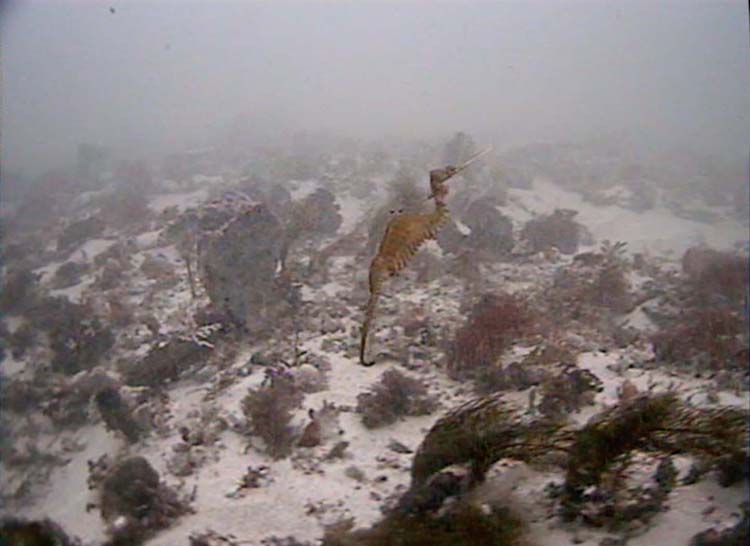^Top image: Marine researchers captured images of the rare ruby seadragon hovering above the sea floor off the coast of Australia. Credit: Scripps Institution of Oceanography/UC San Diego
Australia’s rare ruby seadragon has recently been seen alive for the first time. Because of rough sea conditions, a team of researchers had just one day to find the elusive “monster” off the coast of southern Australia. The ruby seadragon lives in waters too deep for human divers, so the team used a remote-controlled submersible (undersea vessel) to scour the murky sea bottom. After several attempts, on the team’s last try, the submersible’s camera finally captured the first images of a living ruby seadragon.
The story sounds like science fiction, but it actually happened. Marine biologists (scientists who study ocean life) Greg W. Rouse and Josefin Stiller from the Scripps Institution of Oceanography in California and Nerida G. Wilson from the Western Australian Museum captured video footage of the fish last year. They published their findings January 12 in the journal Marine Biodiversity Records.

^The ruby seadragon was recently identified as a new species different from leafy and weedy seadragons. Credit: Scripps Institution of Oceanography/UC San Diego
Seadragon is the common name for several kinds of fish similar to seahorses. Like seahorses, seadragons have a long snout and skin covered in bony plates. But seadragons generally grow larger than seahorses, and they have flatter bodies fringed with unusual skin flaps. The two most well-known species (kinds) are the weedy (or common) seadragon and the leafy (or Glauert’s) seadragon. Both species typically live in reefs or among seaweed off southern Australia. The creatures take on the appearance of seaweed, enabling them to hide from predators (hunting animals). Despite their fearsome name, seadragons are fragile and delicate, no danger to humans, and grow to only about 18 inches (45 centimeters) in length.
Leafy and and weedy seadragon species have been known to inhabit the southern shores of Australia for some time, but some specimens had baffled scientists for many years. A few bright red seadragons with no leafy appendages were collected by trawling (collecting fish with funnel shaped nets) or found washed up on beaches. Because all these creatures were dead, scientists assumed they were leafy or weedy seadragons that had been damaged by the trawls or had decayed before they were collected. In 2015, however, the same team of Rouse, Stiller, and Wilson analyzed samples of these “damaged” specimens’ DNA and discovered that they were in fact a new species: the ruby seadragon, Phyllopteryx dewysea. No one had seen a living ruby seadragon, however, so the team set out to find one.
Leafy and weedy seadragons live in seaweed forests at depths accessible to skin divers. The ruby seadragon, however, lives in deeper water, more than 160 feet (50 meters) below the surface. At that depth, its coloration, while brilliant on land, actually acts as camouflage. In deep water, red wavelengths of light are absorbed, allowing the ruby seadragon to blend in with the drab sponges that populate the seafloor. Now that a live ruby seadragon has been spotted, the race is on to determine its range and how its habitat can be protected.
Untitled Document Can't view the linked articles? Subscribe to World Book Online

World Book Online delivers a progressive sequence of core databases supported by supplemental
tools, such as language translation, graphic organizers, and unique Webquests. Moving from
Early World of Learning to World Book Advanced, World Book Online aligns end-users with their
appropriate learning levels. Each stand-alone site provides additional features to support the
needs of users’ specific capabilities.
The World Book Difference
World Book combines cutting-edge technology with traditional editorial excellence to produce
authoritative, trustworthy, and unbiased content. The digital content is updated in real time and
carefully curated for each learning level. Accessible 24/7, the content is available on a variety of devices.
World Book Online combines 21st-century instructional techniques with timely information.
By breaking down complex topics and using easily understandable text, World Book Online helps to
build fluency and increase comprehension. Featuring single sign-on capability, these sites are paired
with highly visual content to engage even the most reluctant reader. Our collection of resources kindles
a lifelong learning experience for every user. This adherence to clarity, currency, and accuracy makes
World Book’s digital offerings an information hub for the classroom, library, and beyond.